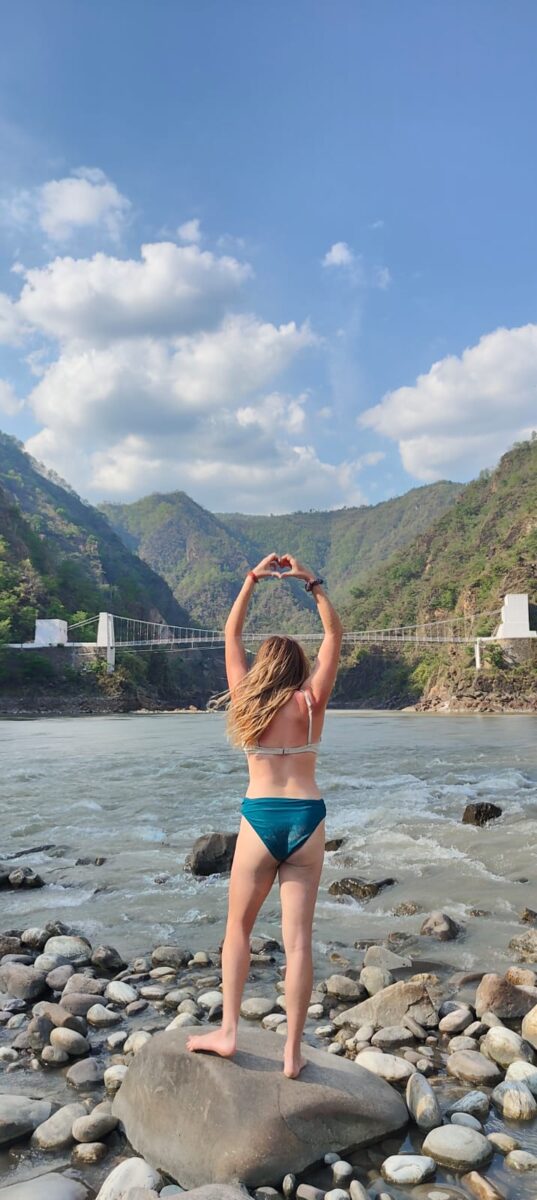By Kayla, Doctor of Physiotherapy
For a long time, I believed I understood the body.
I studied it intensely — first with a Bachelor’s in Exercise Science, then through years of clinical training as a Doctor of Physical Therapy. I knew muscles, bones, nerves, biomechanics, physiology. I could assess dysfunction and prescribe rehab with precision. I exercised religiously — lifting weights, running, swimming, cycling — five days a week, every week. From the outside, I was “healthy.” According to the American health standards, I was ticking all the boxes.
But I was disconnected.
I could recite the names of every muscle in the body — but I couldn’t feel what was happening inside my own. I could break down gait mechanics in my sleep — but I didn’t know I was breathing with just my chest most of the day. My own posture, tension, breath, and anxiety were invisible to me, buried under the busyness of achievement and intellectual pursuit.
The Turning Point
Things shifted when I came to India for the first time in 2018.
Yoga wasn’t new to me — but until then, I had always seen it as another workout. Something to supplement my physical health routine. I didn’t understand what the postures were pointing toward. During my first Yoga Teacher Training (TTC), I got a glimpse of a different kind of knowledge — not from books or journals, but from experience. Still, I was too deep in my DPT graduate studies to truly absorb it.
I returned to the U.S., continued my studies, taught yoga on the side, integrated some of what I’d learned — but the internal shift hadn’t fully landed.
Then, after finishing my residency, I returned to India for a 300-hour TTC. Something in me cracked open. I realized how much more there was to feel. To process. To integrate.
And just a few months later, I made a radical decision:
To let go of the career plan. The steady salary. The apartment. The retirement goals.
To stay in India and pursue something far less defined — myself.
The Real Work Begins
The real transformation began when I chose to stay in India.
In those first few months, something foundational began to form — not just through formal training, but through the people, places, and practices I immersed myself in. One of the most pivotal parts of this early chapter was meeting Amit, my now partner.
We met on the banks of Ganga ji — two curious movers who spoke the same language without needing many words. What began as a spontaneous teaching exchange soon grew into a rhythm: living, practicing, and exploring movement side by side for months. We swam, danced, experimented with animal flow, floorwork, acrobatics, and Kalari Payattu. Amit brought with him a deep-rooted knowledge of yoga through his Master’s degree, diploma studies, countless trainings, and a lived devotion to his faith. Practicing alongside him offered me something I hadn’t encountered in my clinical world: a living, breathing embodiment of yoga, guided by tradition and faith.
At the same time, I was undergoing my own parallel deep dive — one that shaped me in equally powerful ways. I threw myself into practices that broke down the walls between body, mind, and emotion:
- A yoga therapy course (in addition to my prior 500hr TTC trainings)
- Regular sessions rooted in Hatha, Vinyasa, Ashtanga, and Kriya yoga
- Intensive 8-day Tantra retreats
- Months of movement based meditation practice in a Himalayan ashram, sometimes up to 7 hours a day
This time — a mix of shared exploration and solitary experience — became the ground for everything that followed.
It was during this time that I began to feel my anatomy.
My ankles — tight, stubborn, shaped by years of Western-style training.
My breath — shallow, withheld, an unconscious dysregulation.
My scapula, pelvis, spine — places I had studied in depth, but was only now meeting as living, breathing terrain.
I began to understand that pain wasn’t always about posture — it was about protection.
That tension wasn’t just mechanical — it was emotional.
That trauma lives in tissues, not just thoughts.
Learning to Listen
Through movement, I began accessing memories I had long buried.
Moments of fear, of shame, of heartbreak — all mapped onto my body in subtle patterns.
I realized how often I had ignored my body’s signals — and how hard it had been trying to communicate with me all along.
This is where the real anatomy education began.
Not in books — but in sensation. In presence. In breath. In breakdown and rediscovery.
Why I’m Writing This
I’m still on this journey — integrating, unraveling, learning. But now, I teach from this place.
Not just from my degree, but from the bridge between science and somatics, between rehabilitation and ritual, between anatomy and awareness.
Alongside Amit, I now guide others through their own reconnection.
Through movement, breath, understanding, and embodiment.
Because your body is not just a machine — it’s a map.
A map of memory. Of emotion. Of resilience. Of protection. Of potential.
And when you learn to read it — everything changes.

